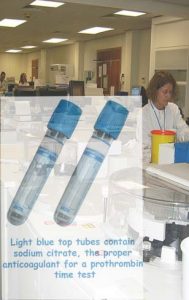Ron Hines DVM PhD
 See What Normal Blood & Urine Values Are
See What Normal Blood & Urine Values Are
 Causes Of Most Abnormal Blood & Urine Tests
Causes Of Most Abnormal Blood & Urine Tests
Your Dog And Cat’s Prothrombin Time = PT
When your veterinarian suggests running a prothrombin time on your dog or cat’s blood, it is because the vet has some questions regarding the ability of your pet’s blood to clot normally.
The mechanism by which blood clots is very complex. It consists of two routes or pathways (the intrinsic cascade pathway and extrinsic cascade pathway); with some steps common to both. Two tests, the Prothrombin Time (PT) and the Partial Thromboplastin Time (PTT or aPTT) help your veterinarian decide where in this complicated clot process problem(s) might exist.
Your veterinarian might also run the PT test before surgical procedures that have the potential for extensive bleeding. Other tests that help determine why your pet’s blood is not clotting properly are a thrombocyte count, blood fibrinogen level, partial thromboplastin time (PTT), thrombin clot time (TCT) and, perhaps, a d-dimer test.
Prothrombin is a protein produced by your pet’s liver. When it is activated normally during bleeding, it changes very rapidly into another protein called thrombin. When not enough prothrombin is present, your pet’s PT time will be extended (increased). PT primarily measures the extrinsic blood-clotting pathway. It is used in conjunction with activated partial thromboplastin time (aPTT), which primarily measures the intrinsic (slower) clotting pathway. Your veterinarian will use the staff of the clinical laboratory to coach him/her through the intricate process of locating broken links in the clotting process – it is not something your ordinary clinical veterinarian is likely to understand in detail.
Reasons Why Your Cat Or Dog’s Prothrombin Time Might Be Increased (Prolonged):
A vitamin K deficiency can increase clotting time. An important cause of vitamin K deficiency is consumption of certain rodent poisons.
Administration of medications to dissolve or prevent blood clots (e.g. Coumadin, warfarin) such as might be used to dissolve the clots that form as saddle thrombi in cats with cardiomyopathy.
Chronic liver disease can prevents normal prothrombin formation leading to extended prothrombin time.
Genetic tendency toward bleeding occasionally occur in dogs and cats (hemophilia). (Some that have been discovered are deficiencies in coagulation factor, VII, V, II or I).
A bit less than half of dogs and cats that develop disseminated intravascular coagulation (DIC) experience abnormally long PT times.
PT times tend to be longer in newborn cats and dogs.
Sulfa-type antibiotics, such as trimethoprim/sulfa has been known to increase bleeding and extend PT time.
Prothrombin time results from one lab do not compare well to results obtained from another laboratory. When you are monitoring a pet over time, it is best to always use the same laboratory.
Reasons Why Your Cat Or Dog’s Prothrombin Time Might Be Decreased (Shortened):
Inflammation anywhere in your pet’s body can decrease its prothrombin time – although the aPTT assay is more accurate in picking up inflammatory situations.
Complementary Tests:
CBC / WBC and blood chemistry values, including observation for elevated AST, ALT, GGT, AP and a low blood albumen level that are all suggestive of liver problems. Liver problems are a common cause of prolonged PT time. A low thrombocyte count and abnormal red blood cell shapes (poikilocytosis) are sometimes present in DIC.
DxMe
You are on the Vetspace animal health website
Visiting the products that you see displayed on this website help pay the cost of keeping these articles on the Internet.


